Big Data — so much information, we had to invent new words like zettabytes to measure it.
Every time you open an app, search something on Google, or stream a show, you’re creating data. Billions of people do this every day, and all those clicks, views, and swipes add up fast.
That information gets tracked, stored, and turned into insights used by businesses, governments, and tech platforms.
What once felt like a few gigabytes has grown into something massive. We’re now creating more data in a single day than the world created in entire decades not long ago.
So, how big is Big Data really? Who’s using it, and what are they doing with it?
In this article, we’ll break down the key Big Data stats that show just how fast it’s growing, what’s driving it, and what it means for the future.

Top Big Data Stats
Data is now central to how decisions are made, services are delivered, and digital systems evolve.
With usage spanning nearly every industry and platform, the scale of Big Data in 2025 offers a clear picture of just how dependent modern systems have become on constant data flow.
These key Big Data stats give a snapshot of where we are and where things are heading.
1. The Big Data market is expected to hit $90 billion in 2025.
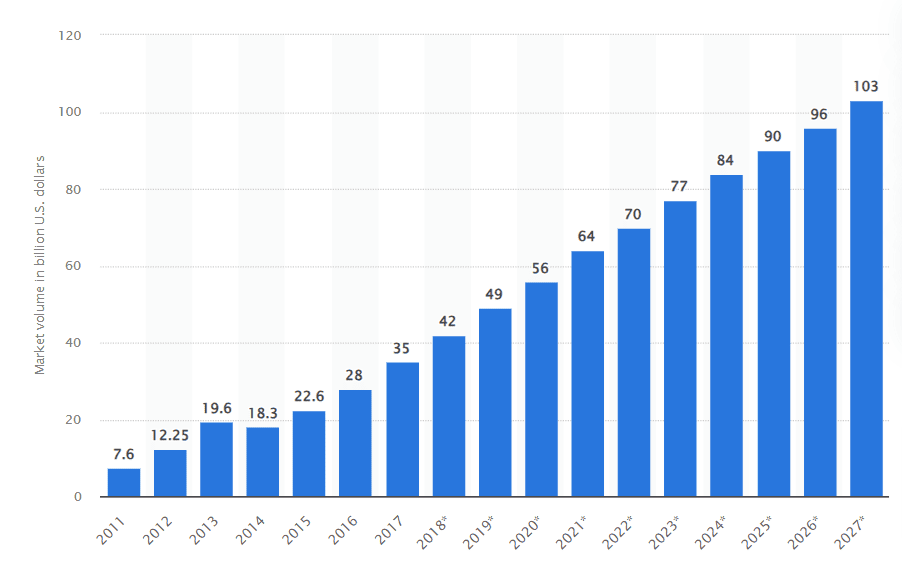
Big Data market size
2. Every single day, we create about 2.5 quintillion bytes of data—that’s a 2 followed by 18 zeros.
3. More than 57% of all data in the world comes from internet users, and 70% of global data is created directly by people online.
4. By 2025, over 80% of companies expect to be handling massive amounts of data called zettabytes, but over a third say they won’t have the tools or systems to manage it properly.
5. A massive 90% of the world’s data was created in just the last two years alone.
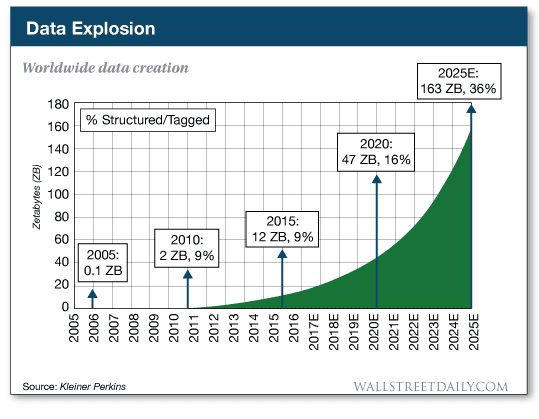
Data created during last two years
6. In healthcare, Big Data analytics could become a $79.23 billion industry by 2028, helping doctors and hospitals make smarter decisions.
7. The Big Data industry is expected to keep growing by 13% every year, and by 2032, it could be worth more than $924 billion.
8. While over 97% of businesses have spent money on Big Data tools, only 40% are actually using them well to make decisions.
9. According to Keywords Everywhere, more than 200,000 people search for “Big Data” on Google every month, showing that interest in the topic is growing fast.
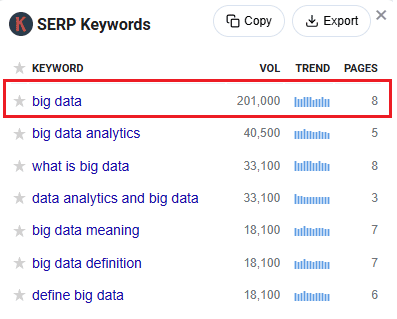
How Big is Big Data in 2025?
In 2025, the world will produce data at a scale that no longer fits traditional comparisons.
Internet usage, device connectivity, and cloud applications all contribute to a daily output that stretches into hundreds of millions of terabytes.
This section of Big Data stats outlines the sheer volume of data we’re generating every minute, and why it keeps increasing.
10. Every second, the world creates about 3.81 petabytes of data—that’s enough to fill thousands of high-end computers in just a blink.
11. That adds up to around 13.75 exabytes every hour, and more than 120 zettabytes of total data worldwide so far.
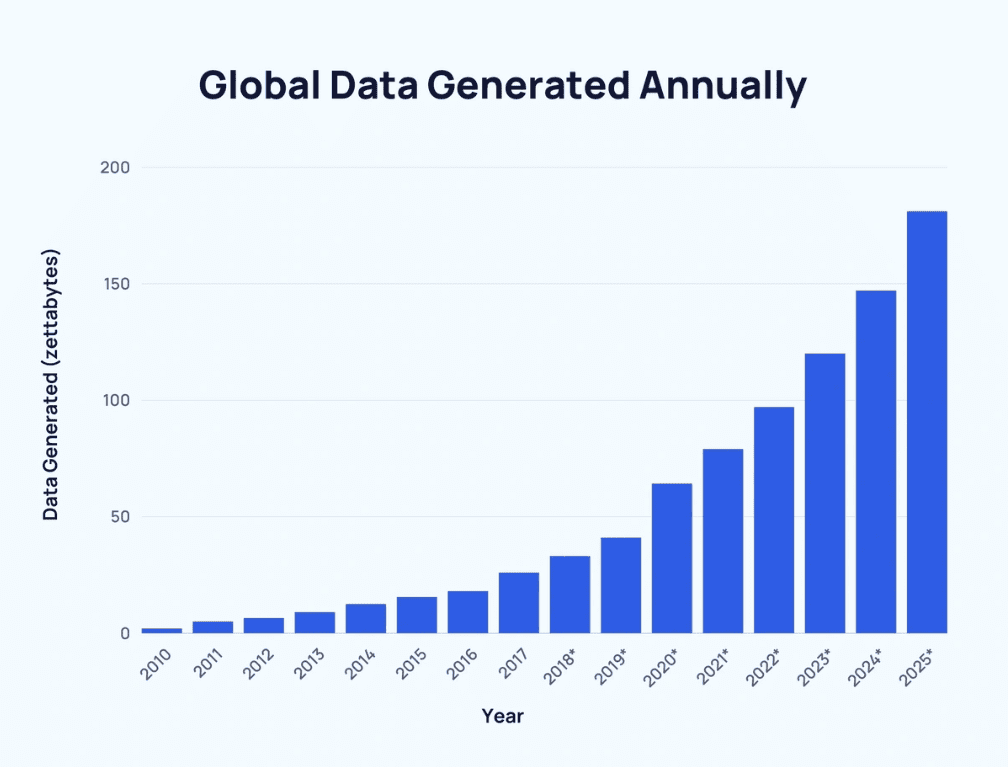
Global data generated annually
To break it down:
- 2.5 million terabytes are created every day
- 104,000 terabytes every hour
- 1,736 terabytes every minute
- And 29 terabytes every second
12. Just one minute online shows how fast we’re adding to the world’s data. Here’s what happens every 60 seconds across the internet:
- People make around 6.3 million Google searches
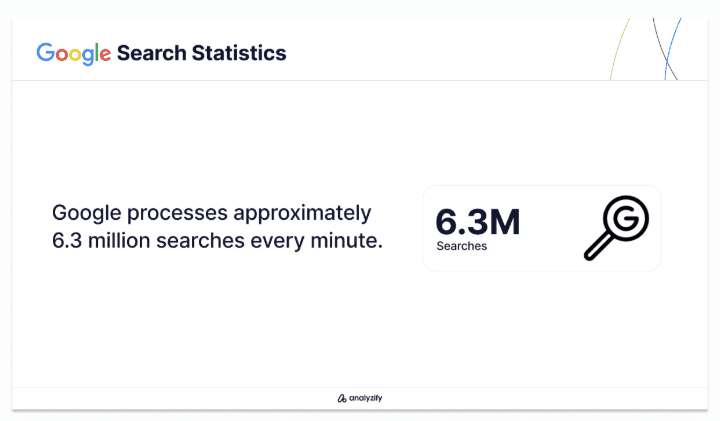
Google searches every minute
- 97.2 million messages are sent through WhatsApp
- Instagram users post about 2166,000 photos
- Facebook sees 1.7 million new posts
- 6,060 resumes are uploaded on LinkedIn
- YouTube gets 500 hours of new video
- Snapchat users send 2.4 million Snaps
- Around 347,000 tweets go live on Twitter
- Over 240 million emails are sent
- 18,800,000 text messages are sent
- Venmo processes $437,600 in payments
- Amazon shoppers spend roughly $443,000
- And yes, 69,400 Taylor Swift songs are streamed
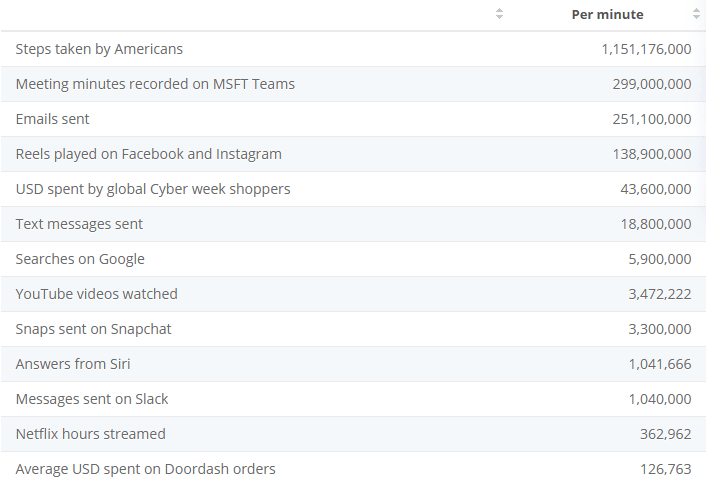
Media usage in an internet minute
Global Big Data Market Size & Growth Stats
The economic footprint of Big Data has expanded steadily over the last decade.
Market valuations now stretch well into the hundreds of billions, with projections showing strong growth through 2030.
These Big Data stats break down current market size, compound annual growth rates, and how different regions compare in investment and adoption.
13. The global Big Data market is on track to hit $103 billion by 2027, and it’s not slowing down anytime soon.
14. Between 2023 and 2028, the market is forecasted to grow by about 12.7% each year.
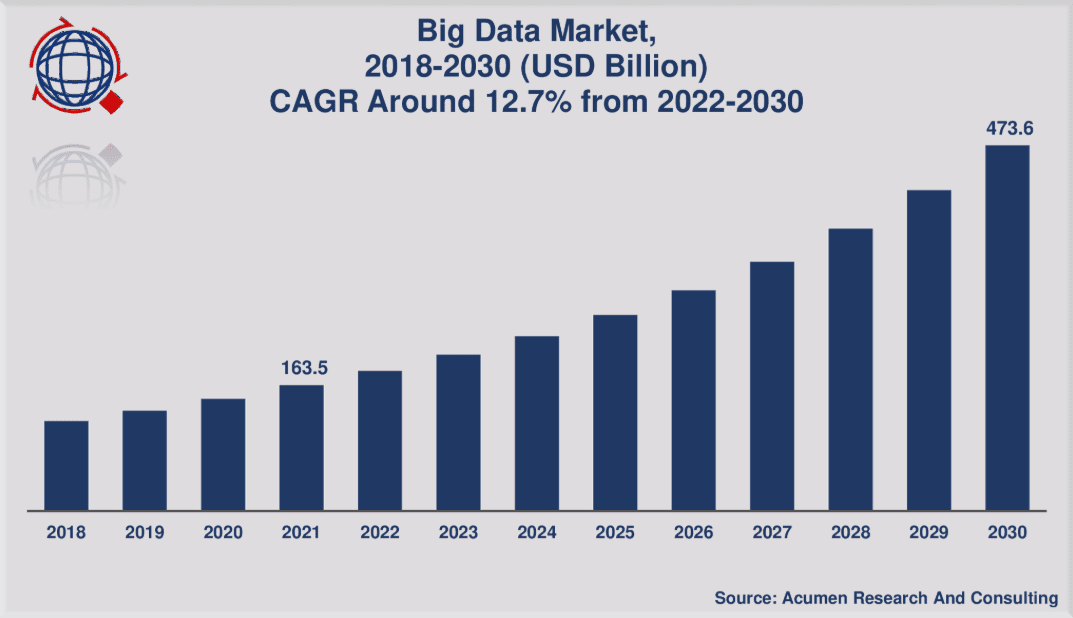
Big Data market growth
15. In North America, Big Data analytics is set to reach $169.91 billion by 2028, making it one of the strongest regions for growth.
16. Europe is also keeping pace, with its Big Data market expected to grow to $105.82 billion by 2027.
17. By 2025, the world will generate over 180 zettabytes of data, a number that would’ve seemed impossible just a few years ago.
18. The Big Data industry overall is expected to grow to $401.2 billion by 2028, showing just how important data is becoming to every major sector.
19. By 2027, software is expected to be the biggest part of the Big Data market, making up about 45% of the entire industry.
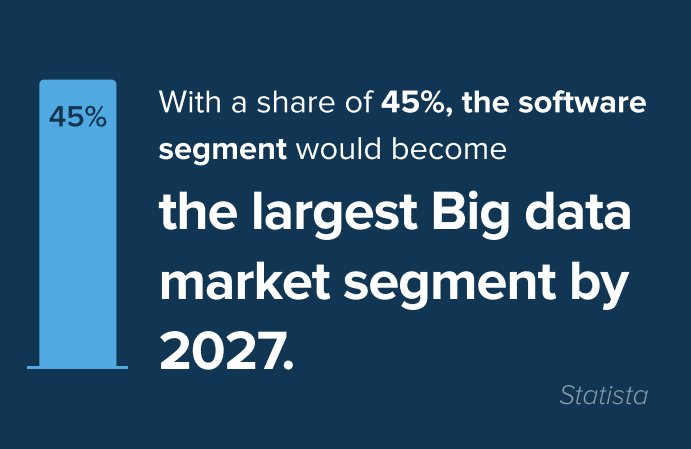
Software will be the largest Big Data market segment
20. Business intelligence tools powered by Big Data will be worth around $63.5 billion by 2028.
21. In 2025 alone, the world is expected to create around 463 zettabytes of data, and the Big Data market will be valued at about $229.4 billion that year.
22. The United States leads the way, holding over 50% of the global market share in Big Data and analytics solutions.
Big Data Adoption Across Industries Stats
The adoption of Big Data is no longer limited to early adopters or tech firms. Organizations across healthcare, finance, retail, and manufacturing are integrating analytics into daily operations.
Let’s see the Big Data stats to examine which industries are moving fastest and how implementation levels have changed over time.
23. About 80% of what people watch on Netflix is picked with help from its recommendation algorithm. It’s not just good for users—it’s saved the company around $1 billion and helped keep viewers coming back.
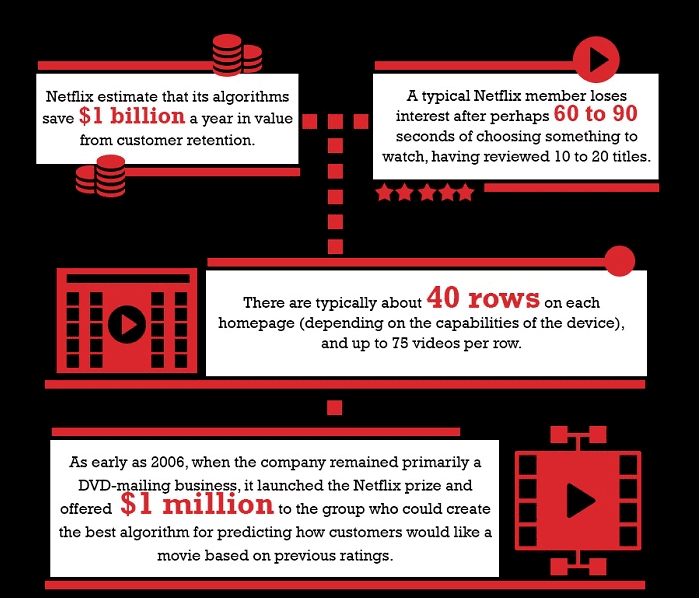
How Netflix use Big Data to drive success
24. Target saw a 15% jump in global revenue within a year after using Big Data to fine-tune its pricing strategies.
25. Walmart cut overstocked items and out-of-stock issues by 30% thanks to Big Data-powered demand forecasting.
26. The Big Data market in healthcare is expected to reach $540 billion by 2035, as more providers use it to improve care and lower costs.
27. At Corewell Health, using Big Data helped reduce patient readmissions by 200 and saved $5 million.
28. In FinTech, the market for Big Data analytics is expected to grow to $141.5 billion by 2026.
29. American Express cut down fraud by 60% using advanced data analysis tools to catch suspicious activity faster.
30. About 2 in 3 travel brands plan to invest in tools like predictive analytics and business intelligence to stay competitive.

Share of travel brands that want to invest in business intelligence or predictive analytics
31. In manufacturing, roughly 3 in 4 executives say they rely on advanced data to improve how things get done on the ground.
32. In real estate, 30% of professionals say automation will have the biggest short-term impact, while 27% point to Big Data and analytics.
33. From 2020 to 2027, predictive analytics in real estate is expected to grow by 23.8% each year, as more companies look to use data for smarter decisions.
34. In supply chain management, Big Data is expected to grow into a $7.1 billion global market by 2027.
35. About 1,400 universities now use predictive analytics to improve student outcomes. Georgia State, for example, raised its graduation rate by 23% since 2003 with the help of data tools.
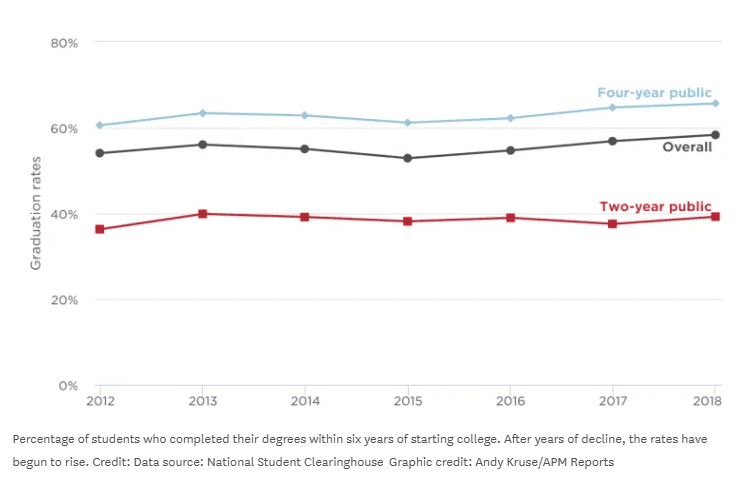
Colleges are using Big Data to boost graduation rates
Big Data and Business Stats
Data analytics is directly influencing strategic planning, customer engagement, and operational decisions.
Companies that prioritize data are seeing measurable improvements in efficiency, profitability, and agility.
These Big Data stats show how deeply Big Data is embedded in core business functions:
36. Over 97% of businesses around the world have invested in Big Data, but only 24% actually use that data to make smarter decisions.
37. Among companies with a solid data strategy, 89% say they make better decisions, and 87% report happier customers as a result.
38. More than 90% of organizations are already using Big Data to guide their business choices.
39. In a survey of Fortune 1000 executives, 48.4% said their companies are now seeing real results from their Big Data investments. Even more telling, over 80% of those executives said their Big Data projects have been overall successful.
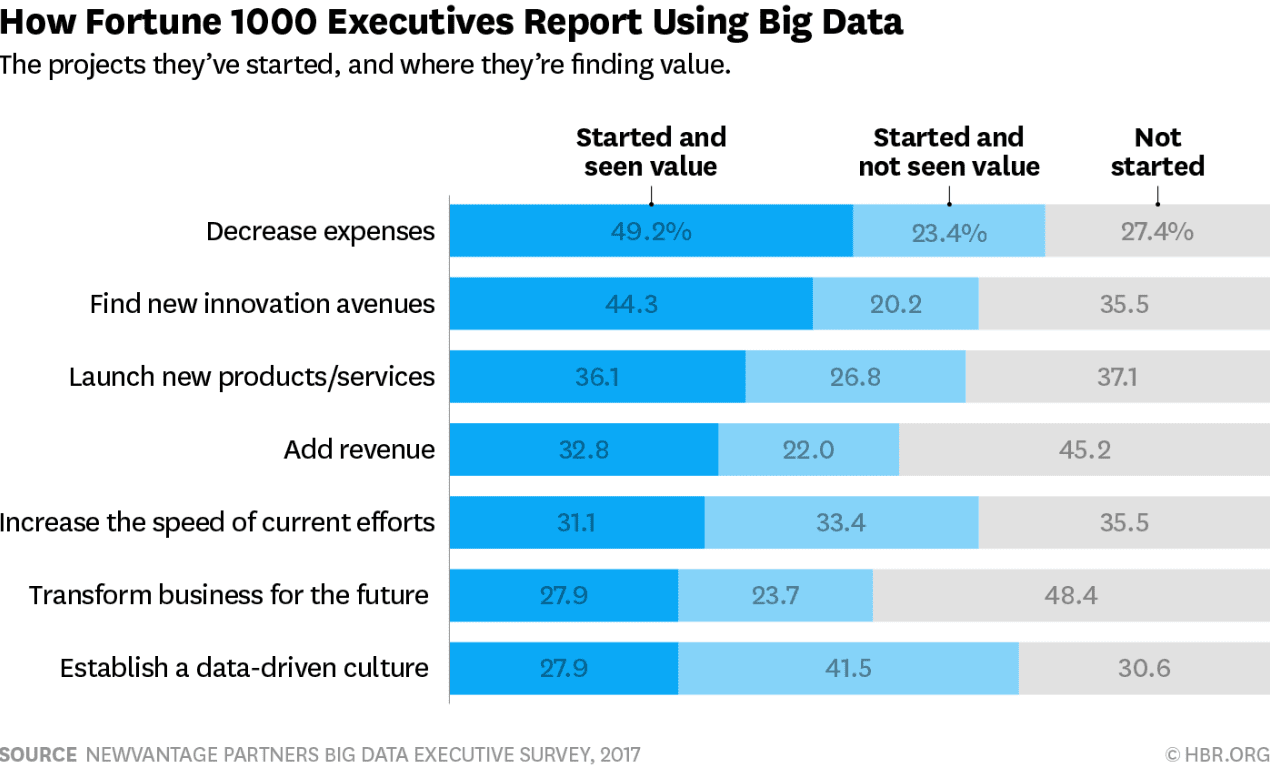
How Fortune 1000 executives report using Big Data
40. A global survey in 2023 found that over 75% of companies use data to push innovation, and half say they compete using analytics.
41. According to Forbes, nearly 88% of companies have increased their spending on data and analytics tools.
42. When it comes to results, 27% of business leaders say their Big Data investments have brought in strong profits. 45% broke even, and 12% actually lost money.
43. Across the board, about 60% of businesses are using data to drive innovation, while nearly 40% treat data as a core business asset, not just information.
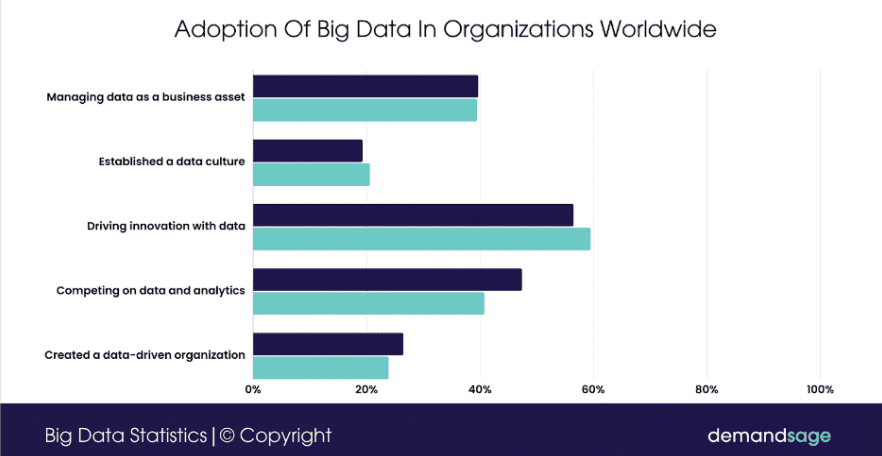
Adoption of Big Data in organizations
44. Businesses that use data and analytics often see a boost in performance or profits of at least 11%.
45. Among companies with more advanced data strategies, 54% have increased revenue, and 44% say they’ve gained a competitive edge.
Cloud, Edge, and Hybrid Infrastructure in Big Data
Storing data isn’t as simple as it used to be.
While a lot of companies still rely on the cloud, more are starting to use edge and hybrid systems to keep things running faster and smoother.
In this section, we’ll look at how businesses are handling their growing data and why their storage choices matter more than ever.
46. The hybrid cloud market is currently worth over $172 billion, and it’s expected to grow fast, reaching $311 billion by 2030.
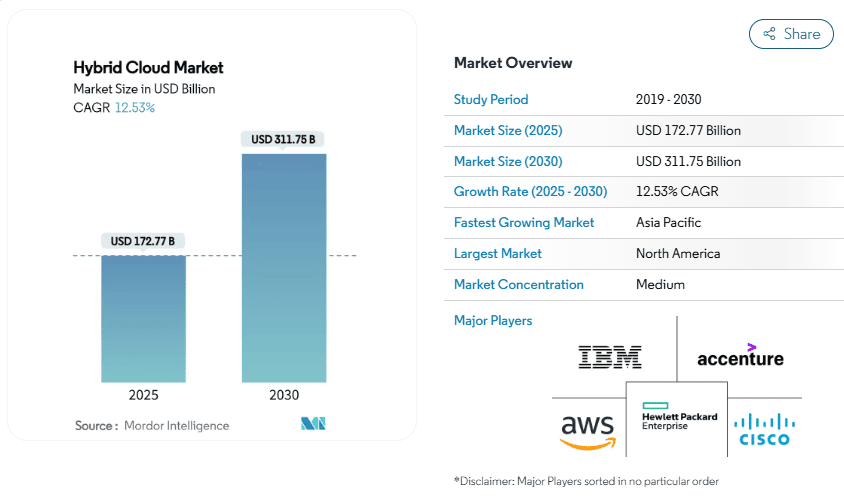
Hybrid cloud market 2025
47. Right now, about 45% of businesses use the cloud to handle at least part of their Big Data workload.
48. More than 60% of company data is now stored in the cloud, and by 2025, that number could hit 100 zettabytes worldwide.
49. In a G2 survey, 48% of hybrid cloud users said one of the biggest benefits is how well it handles large amounts of data.
50. The edge computing market was only worth $2.49 billion in 2020, but it’s on track to reach $68.71 billion by 2030 as more companies look for faster processing.
51. There are around 11,800 data centers operating across the globe. The U.S. alone has more than Germany, the U.K., China, and Canada combined.
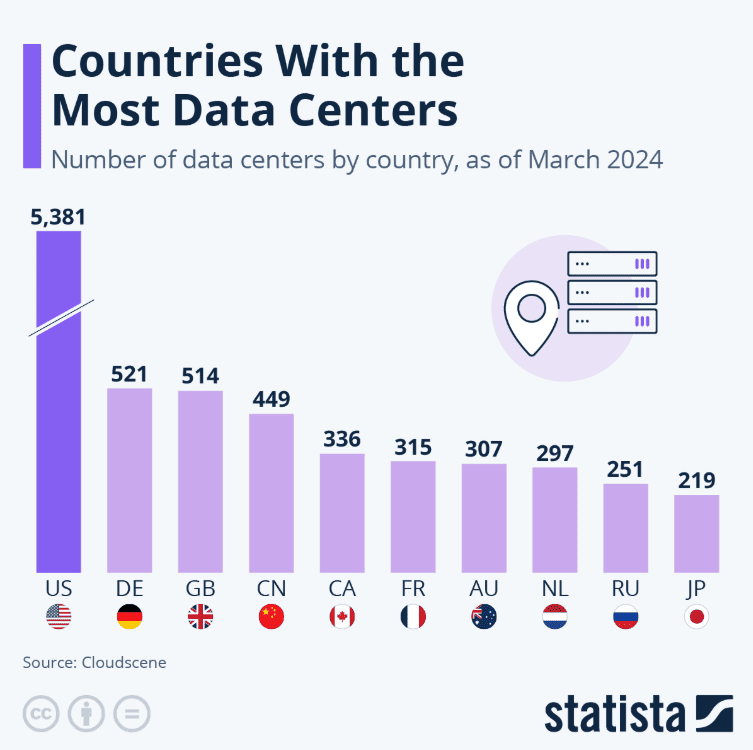
Countries with the most data centers
52. In a 2021 survey, only 70% of cloud budgets were seen as being spent effectively, showing there’s still room to improve how cloud resources are managed.
53. The insurance and telecom industries plan to use around 11.4 different cloud platforms on average, while most large companies already juggle about 8 clouds across departments.
Big Data Challenges Stats
Big Data keeps growing, but that doesn’t mean every company knows what to do with it.
From storage limits to skill gaps and outdated tools, many businesses are finding it hard to turn all that data into real results.
Even with major investments, success isn’t guaranteed—and for some, it’s a struggle just to keep up.
Here are the Big Data stats that reveal many challenges that organizations are still working to overcome.
54. 68% of public sector organizations say data privacy is one of their biggest challenges when dealing with Big Data.
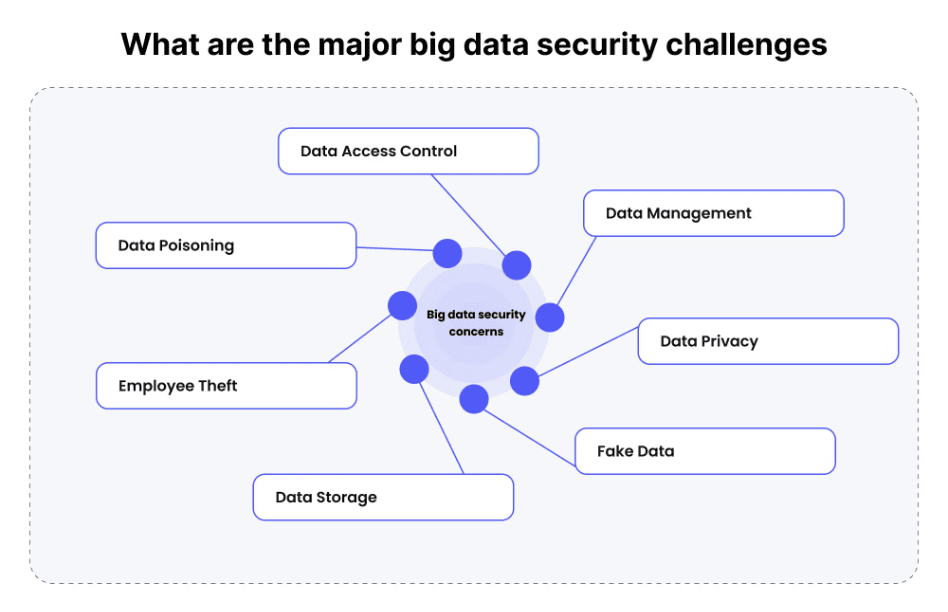
Big data security challenges
55. Many companies find Big Data expensive to manage, with one estimate showing that running a 30TB open-source data warehouse can cost about $1 million a year.
56. Nearly 7 in 10 C-suite executives say their biggest concerns with Big Data are security risks and privacy issues. Other top concerns include metadata and data governance (41%) and slow data ingestion (31%), which can hold up important projects.
57. More than 80% of IT leaders say their analytics work often gets delayed because the data isn’t in the right format when they need it.
58. 8 in 10 companies have had to redo data projects because of bad data quality.
59. 81% of people believe that the risks of companies collecting their data are greater than the benefits. At the same time, most Americans say they’re worried about how their data is being used—79% are concerned about companies, and 64% are concerned about the government.
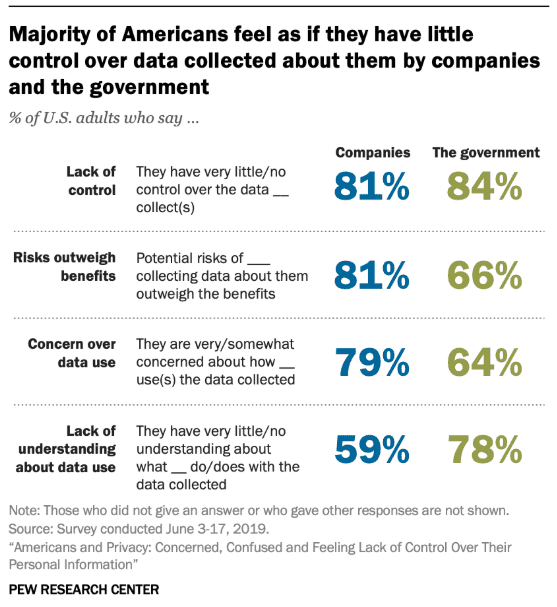
Americans are concerned about lack of control over their personal information
60. 76% of businesses say they struggle to understand their data clearly, and 82% face ongoing problems managing it.
Future Outlook for Big Data
The amount of data we create keeps growing, and that’s not changing anytime soon.
What is changing is how we use that data to work smarter, make faster decisions, and create better experiences.
Here are the Big Data stats that reveal where Big Data is going next and what the future might look like if current trends continue.
61. The demand for data science jobs is rising fast. Data scientist roles are expected to grow by 35% by 2033, with tech giants like Google and Facebook increasing their data teams by about 20% every year.
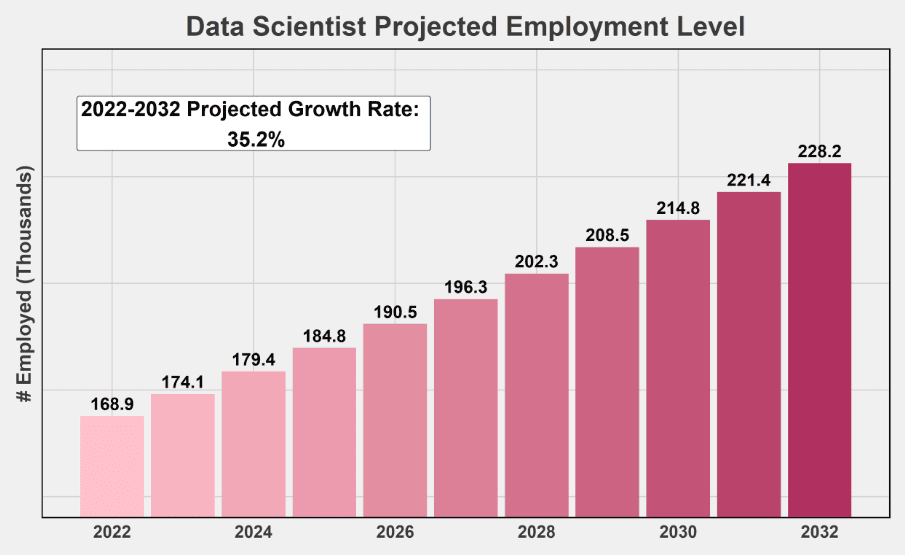
Future of the data science job market
62. AI and ML are playing a bigger role in Big Data, helping companies automate tasks and make better decisions faster. By 2025, AI could be generating $3.9 trillion in business value worldwide.
63. 75% of companies say they expect big improvements by using AI-powered tools that combine artificial intelligence and Big Data.
64. More companies are turning to Big Data to get actionable insights—information they can actually use. For example, IBM Watson Health has helped cut patient readmissions by 15% using Big Data analytics.
65. By 2025, around 6 billion people—that’s 75% of the world’s population—will be creating or using data in some way every day.
Conclusion
By the time you finish reading this, the world will have created thousands of terabytes of new data, and that number keeps climbing every second.
Big Data isn’t slowing down anytime soon.
As more devices connect and more people go online, the need to store, manage, and make sense of all that information will only grow. Businesses that know how to use it well will stay ahead.
But it’s not just about collecting more data.
The real challenge is doing it smartly—without wasting money or losing trust.
As the Big Data world keeps evolving, companies will need to balance growth with better privacy, stronger security, and clear value for the people behind the numbers.


